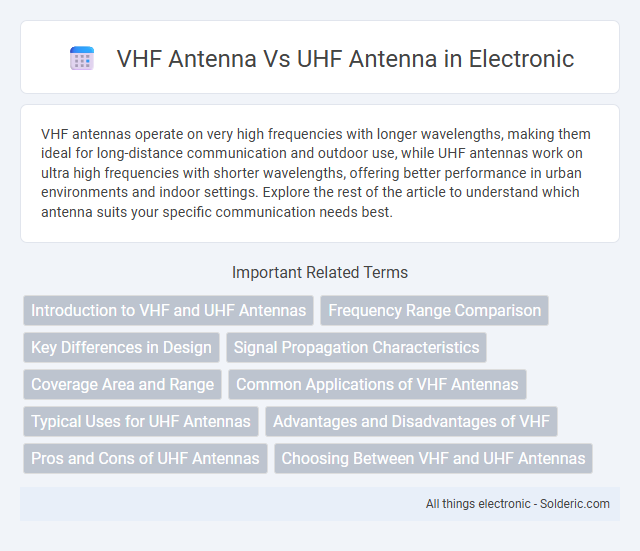VHF antennas operate on very high frequencies with longer wavelengths, making them ideal for long-distance communication and outdoor use, while UHF antennas work on ultra high frequencies with shorter wavelengths, offering better performance in urban environments and indoor settings. Explore the rest of the article to understand which antenna suits your specific communication needs best.
Comparison Table
| Feature | VHF Antenna | UHF Antenna |
|---|---|---|
| Frequency Range | 30 MHz to 300 MHz | 300 MHz to 3 GHz |
| Wavelength | 1 to 10 meters | 10 cm to 1 meter |
| Signal Penetration | Better through buildings and terrain | Less effective through obstacles |
| Range | Longer range with lower frequency | Shorter range, higher frequency |
| Antenna Size | Larger due to longer wavelength | Smaller and compact |
| Applications | Radio broadcasting, emergency services, marine communication | Television broadcasting, mobile phones, Wi-Fi, GPS |
| Signal Quality | Less prone to attenuation in open areas | Better suited for high data rate transmission |
Introduction to VHF and UHF Antennas
VHF antennas operate within the 30 MHz to 300 MHz frequency range, making them ideal for long-distance communication and better penetration through obstacles like buildings and foliage. UHF antennas function between 300 MHz and 3 GHz, offering higher bandwidth and improved signal clarity for short-range and indoor use. Your choice between VHF and UHF antennas depends on the specific application, terrain, and desired communication distance.
Frequency Range Comparison
VHF antennas primarily operate within the 30 MHz to 300 MHz frequency range, ideal for longer-distance communications and better penetration through obstacles. UHF antennas function between 300 MHz and 3 GHz, offering higher bandwidth and improved signal quality for urban and indoor environments. The distinct frequency ranges directly impact antenna size, range, and application in radio, television broadcasting, and wireless communication systems.
Key Differences in Design
VHF antennas are designed with longer elements to accommodate the lower frequency range of 30 MHz to 300 MHz, resulting in larger physical sizes and longer wavelengths. UHF antennas feature shorter elements optimized for higher frequencies between 300 MHz and 3 GHz, enabling more compact designs suitable for urban environments. The design variations directly influence their performance characteristics, with VHF antennas providing better range in open areas and UHF antennas excelling in indoor or densely built locations.
Signal Propagation Characteristics
VHF antennas operate within the 30 MHz to 300 MHz frequency range, enabling signals to travel longer distances and penetrate obstacles like buildings and terrain more effectively due to their lower frequency and longer wavelengths. UHF antennas, covering 300 MHz to 3 GHz, transmit higher-frequency signals with shorter wavelengths that provide better resolution and bandwidth but are more susceptible to attenuation from physical barriers. The choice between VHF and UHF antennas depends on the specific environment and application, balancing signal range and the ability to navigate obstructions.
Coverage Area and Range
VHF antennas typically offer longer range and better coverage over open terrain due to lower frequency signals that can travel further and penetrate obstacles more effectively. UHF antennas provide superior performance in urban environments with dense buildings, offering improved signal quality and reduced interference within shorter ranges. Your choice between VHF and UHF antennas should consider the specific coverage area and the environmental conditions to optimize communication range.
Common Applications of VHF Antennas
VHF antennas are widely used in marine communication, aviation, and emergency services due to their ability to transmit signals over longer distances and through obstacles like buildings and trees. You'll often find VHF antennas integrated into handheld radios, marine radios, and public safety communication systems where reliable line-of-sight transmission is crucial. Their frequency range of 30 MHz to 300 MHz makes them ideal for broadcasting, two-way radio, and outdoor communication applications.
Typical Uses for UHF Antennas
UHF antennas are predominantly used for television broadcasting, mobile phones, GPS devices, and two-way radios due to their higher frequency range of 300 MHz to 3 GHz, which allows for better penetration through buildings and urban environments. These antennas are favored in metropolitan areas where signal reflections and obstructions are common, ensuring clearer reception for digital television and cellular communications. The compact size and directional capabilities of UHF antennas make them ideal for applications requiring focused signal transmission and reception over shorter distances.
Advantages and Disadvantages of VHF
VHF antennas offer longer range and better performance in rural or open areas due to their lower frequency and ability to penetrate obstacles like trees and buildings more effectively. However, VHF antennas tend to be larger and more susceptible to noise and interference from electrical equipment compared to UHF antennas. While ideal for outdoor and wide-area communication, VHF antennas may struggle with urban environments where compact size and signal clarity are crucial.
Pros and Cons of UHF Antennas
UHF antennas offer superior performance in urban and indoor environments due to their shorter wavelengths, enabling better reception of higher frequency signals and improved penetration through buildings. You may face limitations with UHF antennas in open rural areas or long-distance transmissions, as their range and signal strength can be less effective than VHF antennas. The compact size of UHF antennas makes them convenient, but they can be more susceptible to interference and require precise tuning for optimal performance.
Choosing Between VHF and UHF Antennas
Choosing between VHF and UHF antennas depends on the frequency range required for optimal signal reception, with VHF antennas operating typically between 30 MHz and 300 MHz, and UHF antennas functioning between 300 MHz and 3 GHz. VHF antennas are suited for longer wavelengths, offering better performance in open areas and rural environments, while UHF antennas excel in urban settings, penetrating buildings more effectively due to shorter wavelengths. Assessing factors such as transmission distance, terrain, and the specific channel frequencies ensures the selection of an antenna that maximizes signal strength and clarity.
VHF antenna vs UHF antenna Infographic

 solderic.com
solderic.com